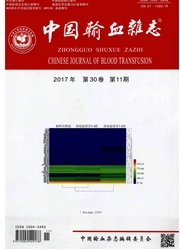

 中文摘要:
中文摘要:
目的研究中国南方汉族人群和西藏藏族人群RHCE基因内含子2中109bp插入序列缺失情况和外显子5中733C〉G多态性,并比较2民族间有无差异。方法收集186例中国南方汉族人样本和50例西藏藏族人样本,应用PCR-SSP方法对内含子2的109bp插入序列和外显子5的733C〉G多态性进行检测,并用测序方法验证。结果在中国南方汉族人群中携带RhC抗原个体其RHCE基因内含子2中109bp插入序列的缺失率为1.08%,在西藏藏族人群中缺失概率为0,二者缺失率相比无统计学差异(x2=0.02,p〉0.05)。2民族所有样本RHCE基因外显子5的733位核甘酸均为G,未发现该位点存在733C〉G多态性。结论2民族在内含子2的109bp插入序列缺失和外显子5的733C〉G多态性方面未发现二者有差异。在南方汉族人群中针对RHCE基因内含子2的109bp插入序列来检测R1LtCc基因会因缺失而导致假阴性错误。
 英文摘要:
英文摘要:
Objective To investigate the 109 bp insert de- letion of intron2, and 733C 〉 G polymorphisms of exon 5 in RHCE gene in Chinese Han and Tibetan populations. To disclose the diversities between the 2 nationalities. Methods 186 sam-pies from southern Chinese Hans and 50 samples from Tibetans were collected. The 1109 bp insertion of intron2 and 733C 〉 G polymorphisms of exon 5 in RHCE gene were detected by PCR-SSP and the results were proved by sequencing. Results The deletion rate of 109 bp insertion of intron 2 of RHCE gene in individuals carrying RhC antigens were 1.08% in southern Chi- nese Han population,while that was 0 in Tibetan population (X2 = 0.02, P 〉 0.05 ). 733C 〉 G polymorphisms of exon 5 of RHCE gene were not detected in two populations. Conclusion There was no differences in 109 bp insertion deletion rate and 733 C 〉 G polymorphisms between Chinese Han and Tibetan populations. It would result in false negative errors using 109 bp insertion of intron2 of RHCE gene to genotype RHC allele in southern Chinese Hans.
 同期刊论文项目
同期刊论文项目
 同项目期刊论文
同项目期刊论文
 期刊信息
期刊信息
